Land Use Dynamics and Ecological Effects of Photovoltaic Development in Xinjiang: A Remote Sensing and Geospatial Analysis
Abstract
1. Introduction
2. Materials and Methods
2.1. Studied Area
2.2. Data Collection and Pre-Processing
2.2.1. Data Sources
2.2.2. Data Processing and Research Methods
3. Results
3.1. Characteristics of the Spatial Distribution of PV Equipment in Xinjiang
3.1.1. Overall Spatial Distribution Characteristics
3.1.2. Spatial Distribution Characteristics Under Land Use Types
3.2. Evolution of Eco-Environmental Indices in Xinjiang, 2000–2020
3.3. Impact Assessment of Photovoltaic Construction in Xinjiang on the Ecological Environment
3.3.1. Characteristics of Time Differences
3.3.2. Characteristics of Spatial Variation
4. Discussion
4.1. Characteristics of Spatial Distribution of Photovoltaic Equipment
4.2. Ecological Impact Assessment of Photovoltaic Construction
4.3. Policy Recommendations
4.4. Shortcomings and Prospects
5. Conclusions
- (1)
- PV equipment in Xinjiang shows an obvious regional imbalance in spatial distribution. PV equipment is mainly concentrated in the northern and eastern regions of Xinjiang. The region with the largest area of distribution of PV equipment in Xinjiang is the Kashgar region, covering 96.19 km2; the region with the smallest area of distribution is the Altay region, covering only 7.31 km2. According to the distribution of land use types, the distribution of PV equipment is mainly concentrated in unutilized land, followed by grassland, and forest land has the lowest distribution of PV equipment.
- (2)
- Between 2000 and 2020, the Remote Sensing Ecological Environment Index in Xinjiang showed significant geographical differences, presenting a spatial pattern of “high in the north and low in the south, high in the west and low in the east, and better in the mountainous areas than in the plains”. The ecological environmental quality is better in the northern and western border mountain forest belt, while the southern and eastern desert hinterland faces greater pressure on its ecological environment.
- (3)
- There are obvious spatial and temporal differences in the impact of PV equipment construction on the ecological environment of Xinjiang’s different regions. Comparing the ecological indices of PV construction areas in 2000 and 2020, the ecological environmental quality of PV areas in about 80% (11 regions) of the prefectures improved, e.g., the improvement in Turpan City and Karamay City is particularly significant. However, there are also three regions where the ecological quality of PV construction zones declined, requiring sustainable development strategies and ecological restoration recommendations. In terms of spatial distribution, the highest ecological environment index of PV construction zones in 2020 was found in the Altay region (0.30) in the northern border regions, while the lowest was found in the Hotan region (0.10) in the southern border regions. The areas with better ecological environmental quality in PV construction zones are mostly concentrated in northern Xinjiang, while those with worse quality are concentrated in southern Xinjiang.
Author Contributions
Funding
Data Availability Statement
Conflicts of Interest
References
- Zareie, Z.; Ahmadi, R.; Asadi, M. A comprehensive numerical investigation of a branch-inspired channel in roll-bond type PVT system using design of experiments approach. Energy 2024, 286, 129452. [Google Scholar] [CrossRef]
- Ren, D.F.; Guo, X.P. The economic use of centralized photovoltaic power generation—Grid connection, hydrogen production or energy storage? J. Energy Storage 2025, 106, 114829. [Google Scholar] [CrossRef]
- Shang, X.W.; Wang, Y.Z.; Huo, Y.; Shi, Z.; Li, H.; Zhang, H.; Guo, H.; Xiao, Z. Climate ecological impact mechanism and vegetation restoration modes of desert photovoltaic power stations. Sci. Soil Water Conserv. 2025, 23, 10–20. [Google Scholar]
- Rehman, H.U.; Hussain, A.; Haider, W.; Ali, S.A.; Kazmi, S.A.A.; Huzaifa, M. Optimal Planning of Solar Photovoltaic (PV) and Wind-Based DGs for Achieving Techno-Economic Objectives across Various Load Models. Energies 2023, 16, 2444. [Google Scholar] [CrossRef]
- Liang, Y.; Rahman, S.U.; Shafaqat, A.; Ali, A.; Ali, M.S.E.; Khan, H. Assessing sustainable development in E-7 countries: Technology innovation, and energy consumption drivers of green growth and environment. Sci. Rep. 2024, 14, 28636. [Google Scholar] [CrossRef]
- Kaldellis, J.K.; Kapsali, M.; Kavadias, K.A. Temperature and wind speed impact on the efficiency of PV installations. Experience obtained from outdoor measurements in Greece. Renew. Energy 2014, 66, 612–624. [Google Scholar]
- Zhang, H.; Yu, Z.; Zhu, C.; Yang, R.; Yan, B.; Jiang, G. Green or not? Environmental challenges from photovoltaic technology. Environ. Pollut. 2023, 320, 121066. [Google Scholar] [CrossRef]
- Li, P.D.; Gao, X.Q. The impact of photovoltaic power plants on ecological environment and climate: A literature review. Plateau Meteorol. 2021, 40, 702–710. [Google Scholar]
- Liu, Y.; Zhang, R.Q.; Huang, Z.; Cheng, Z.; López-Vicente, M.; Ma, X.R.; Wu, G.L. Solar photovoltaic panels significantly promote vegetation recovery by modifying the soil surface microhabitats in an arid sandy ecosystem. Land. Degrad. Dev. 2019, 30, 2177–2186. [Google Scholar] [CrossRef]
- Gao, X.Q.; Yang, L.W.; Lyu, F.; Ma, L.; Li, H.; Hui, X.; Hu, X. Observational Study on the Impact of the Large Solar Farm on Air Temperature and Humidity in Desert Areas of Golmud. Acta Energ. Sol. Sin. 2016, 37, 2909–2915. [Google Scholar]
- Broadbent, A.M.; Krayenhoff, E.S.; Georgescu, M. The observed effects of utility-scale photovoltaics on near-surface air temperature and energy balance. J. Appl. Meteorol. Climatol. 2019, 58, 989–1006. [Google Scholar] [CrossRef]
- Elminshawy, N.A.S.; Osama, A.; Gagliano, A. A technical and economic evaluation of floating photovoltaic systems in the context of the water-energy nexus. Energy 2024, 303, 131904. [Google Scholar] [CrossRef]
- Chen, X.; Gao, Y.; Zhai, B.; Liu, X.; Cheng, B. Transport of wind-drift sand in photovoltaic electric field in sand area. Arid. Zone Res. 2019, 36, 684–690. [Google Scholar]
- Pratt, R.N.; Kopp, G.A. Velocity measurements around low-profile, tilted, solar arrays mounted on large flat-roofs, for wall normal wind directions. J. Wind. Eng. Ind. Aerodyn. 2013, 123, 226–238. [Google Scholar] [CrossRef]
- Mahmud, M.A.P.; Huda, N.; Farjana, S.H.; Lang, C. Environmental impacts of solar-photovoltaic and solar-thermal systems with life-cycle assessment. Energies 2018, 11, 2346. [Google Scholar] [CrossRef]
- Lambert, Q.; Bischoff, A.; Cueff, S.; Cluchier, A.; Gros, R. Effects of solar park construction and solar panels on soil quality, microclimate, CO2 effluxes, and vegetation under a Mediterranean climate. Land Degrad. 2021, 32, 5190–5202. [Google Scholar] [CrossRef]
- Zhang, C.C.; Zhang, W.F.; Dong, Z.J.; Zhan, X. Impact of photovoltaic arrays on microclimate in desert areas under the background of carbon neutral. J. Gansu Agric. Univ. 2023, 59, 228–236+245. [Google Scholar]
- Chen, H.; Wu, W.; Li, C.; Lu, G.; Ye, D.; Ma, C.; Ren, L.; Li, G. Ecological and environmental effects of global photovoltaic power plants: A meta-analysis. J. Environ. Manag. 2025, 373, 123785. [Google Scholar] [CrossRef]
- Wang, Z.Y.; Wang, J.; Gao, Y.; Dang, X.H.; Meng, Z.J. Impact of photovoltaic power station construction on ecological environment in sandy area. Bull. Soil Water Conserv. 2019, 39, 191–196. [Google Scholar]
- Fan, X.; Wang, W.; Shi, R. Hybrid pluripotent coupling system with wind and photovoltaic-hydrogen energy storage and the coal chemical industry in Hami, Xinjiang. Renew. Sustain. Energy Rev. 2017, 72, 950–960. [Google Scholar] [CrossRef]
- Li, G.; Li, M.; Taylor, R.; Hao, Y.; Besagni, G.; Markides, C. Solar energy utilisation: Current status and roll-out potential. Appl. Therm. Eng. 2022, 209, 118285. [Google Scholar] [CrossRef]
- Cheng, G.S.; Luo, E.C.; Zhao, Y.; Yang, Y.; Chen, B.; Cai, Y.; Wang, X.; Dong, C. Analysis and prediction of green hydrogen production potential by photovoltaic-powered water electrolysis using machine learning in China. Energy 2023, 284, 29302. [Google Scholar] [CrossRef]
- Li, Y.; Kalnay, E.; Motesharrei, S.; Rivas, J.; Kucharski, F.; Kirk-Davidoff, D.; Bach, E.; Zeng, N. Climate model shows large-scale wind and solar farms in the Sahara increase rain and vegetation. Science 2018, 361, 1019–1022. [Google Scholar] [CrossRef] [PubMed]
- Yue, X.; Zhang, L.X.; Zhou, D.C. Spatio-temporal evolution and driving factors of ecological vulnerability in arid and semi-arid typical ecologically fragile areas. Environ. Ecol. 2023, 5, 1–9+14. [Google Scholar]
- Xu, H.Q. Creation and application of urban remote sensing ecological index. Acta Ecol. Sin. 2013, 33, 7853–7862. [Google Scholar]
- Huang, C.; Wylie, B.; Yang, L. Derivation of a tasselled cap transformation based on Landsat 7 at-satellite reflectance. Int. J. Remote Sens. 2002, 23, 1741–1748. [Google Scholar] [CrossRef]
- Chander, G.; Markham, B.L.; Helder, D.L. Summary of current radiometric calibration coefficients for Landsat MSS, TM, ETM+, and EO-1 ALI sensors. Remote Sens. Environ. 2009, 113, 893–903. [Google Scholar] [CrossRef]
- Nichol, J. Remote sensing of urban heat islands by day and night. Photogramm. Eng. Remote Sens. 2005, 71, 613–621. [Google Scholar]
- Xu, H. A new index for delineating built-up land features in satellite imagery. Int. J. Remote Sens. 2008, 29, 4269–4276. [Google Scholar] [CrossRef]
- Rikimaru, A.; Roy, P.S.; Miyatake, S. Tropical forest cover density mapping. Trop. Ecol. 2002, 43, 39–47. [Google Scholar]
- Chang, R.; Luo, Y.; Zhu, R. Simulated local climatic impacts of large-scale photovoltaics over the barren area of Qinghai, China. Renew. Energy 2020, 145, 478–489. [Google Scholar] [CrossRef]
- Yang, J.Y.; Tian, W.; Pan, X.Y. Ecological quality assessment of Xiongan New Area based on remote sensing ecological index. Chin. J. Appl. Ecol. 2019, 30, 277–284. [Google Scholar]
- Xu, Z.; Li, Y.; Qin, Y.; Bach, E. A global assessment of the effects of solar farms on albedo, vegetation, and land surface temperature using remote sensing. Sol. Energy 2024, 268, 112198. [Google Scholar] [CrossRef]
- Xia, Z.; Li, Y.; Guo, S. Satellites reveal spatial heterogeneity in dryland photovoltaic plants’ effects on vegetation dynamics. Earth’s Future 2024, 12, e2024EF004427. [Google Scholar] [CrossRef]
- Tahri, M.; Hakdaoui, M.; Maanan, M. The evaluation of solar farm locations applying Geographic Information System and Multi-Criteria Decision-Making methods: Case study in southern Morocco. Renew. Sustain. Energy Rev. 2015, 51, 1354–1362. [Google Scholar] [CrossRef]
- Günen, M.A. Determination of the suitable sites for constructing solar photovoltaic (PV) power plants in Kayseri, Turkey using GIS-based ranking and AHP methods. Environ. Sci. Pollut. Res. 2021, 28, 57232–57247. [Google Scholar] [CrossRef]
- Xia, Z.; Li, Y.; Chen, R.; Sengupta, D.; Guo, X.; Xiong, B.; Niu, Y. Mapping the rapid development of photovoltaic power stations in northwestern China using remote sensing. Energy Rep. 2022, 8, 4117–4127. [Google Scholar] [CrossRef]
- Kim, J.Y.; Koide, D.; Ishihama, F.; Kadoya, T.; Nishihiro, J. Current site planning of medium to large solar power systems accelerates the loss of the remaining semi-natural and agricultural habitats. Sci. Total Environ. 2021, 779, 146475. [Google Scholar] [CrossRef]
- Zhang, L.; Li, X.; Liu, X.; Lian, Z.; Zhang, G.; Liu, Z.; An, S.; Ren, Y.; Li, Y.; Liu, S. Dynamic monitoring and drivers of ecological environmental quality in the Three-North region, China: Insights based on remote sensing ecological index. Ecol. Inform. 2025, 85, 102936. [Google Scholar] [CrossRef]
- Zhang, Y.; She, J.; Long, X.; Zhang, M. Spatio-temporal evolution and driving factors of eco-environmental quality based on RSEI in Chang-Zhu-Tan metropolitan circle, central China. Ecol. Indic. 2022, 144, 109436. [Google Scholar] [CrossRef]
- Wu, C.; Liu, H.; Yu, Y. Ecohydrological effects of photovoltaic solar farms on soil microclimates and moisture regimes in arid Northwest China: A modeling study. Sci. Total Environ. 2022, 802, 149946. [Google Scholar] [CrossRef] [PubMed]
- Luo, L.; Zhuang, Y.; Liu, H.; Zhao, W.; Chen, J.; Du, W.; Gao, X. Environmental impacts of photovoltaic power plants in northwest China. Sustain. Energy Technol. Assess. 2023, 56, 103120. [Google Scholar] [CrossRef]
- Wang, T. Study on the influence of photovoltaic power station construction on soil and vegetation in Jingbian County. Master’s Thesis, Northwest A&F University, Yangling, China, 2015. [Google Scholar]
- Cui, Y.Q.; Fu, Q.; Sun, J.H.; Xiao, J. A Review of Revegetation Patterns of Photovoltaic Plant in Northwest China. Bull. Soil Water Conserv. 2017, 37, 200–203. [Google Scholar]
- Li, C.; Fu, B.; Wang, S. Drivers and impacts of changes in China’s drylands. Nat. Rev. Earth Environ. 2021, 2, 858–873. [Google Scholar] [CrossRef]
- Liu, S.H.; Gao, Q.; Wang, X.Q. Characteristics of vegetation and soil changes in alpine desert steppe under the interference of photovoltaic power plants. J. Soil Water Conserv. 2016, 30, 325–329. [Google Scholar]

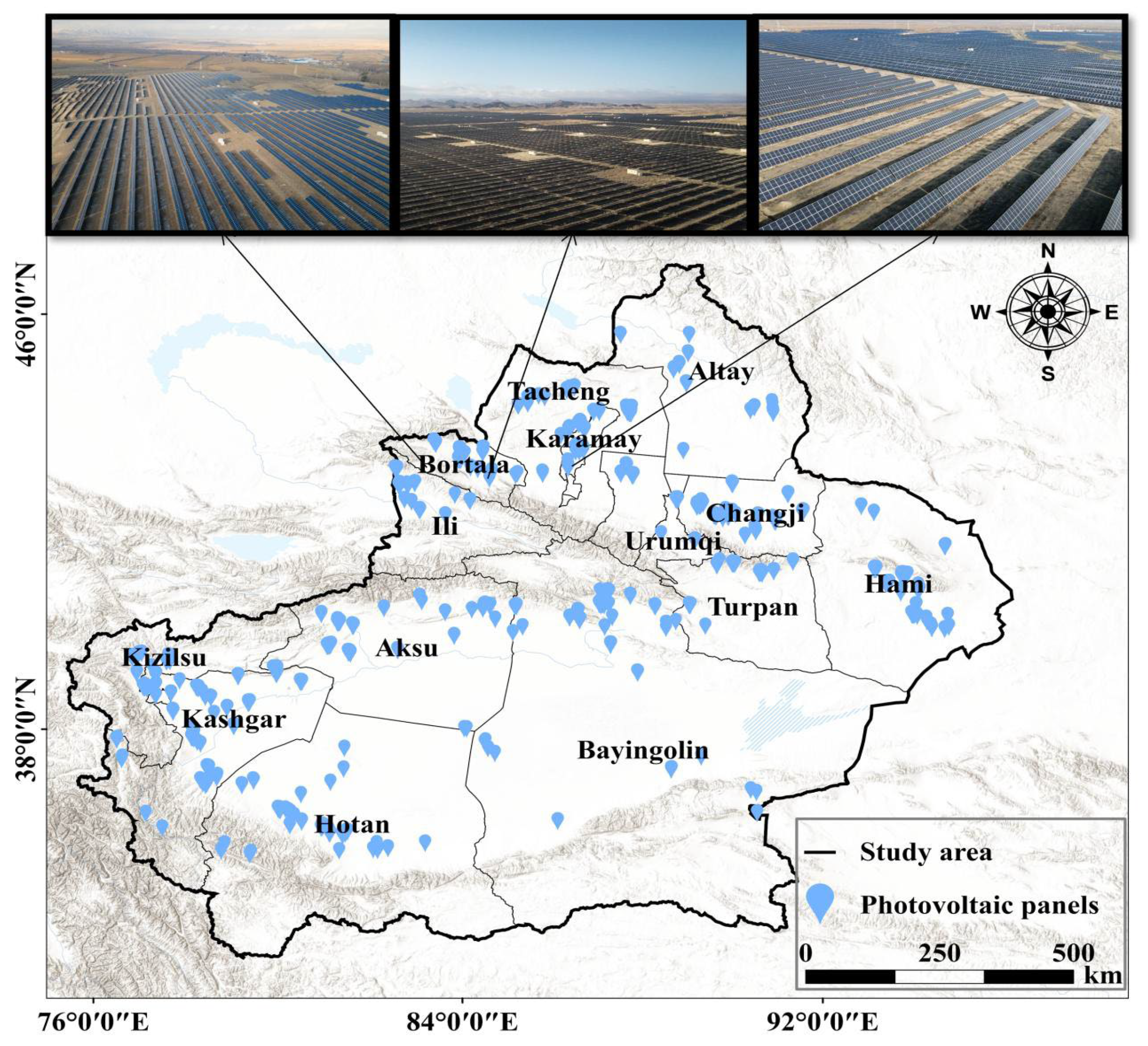

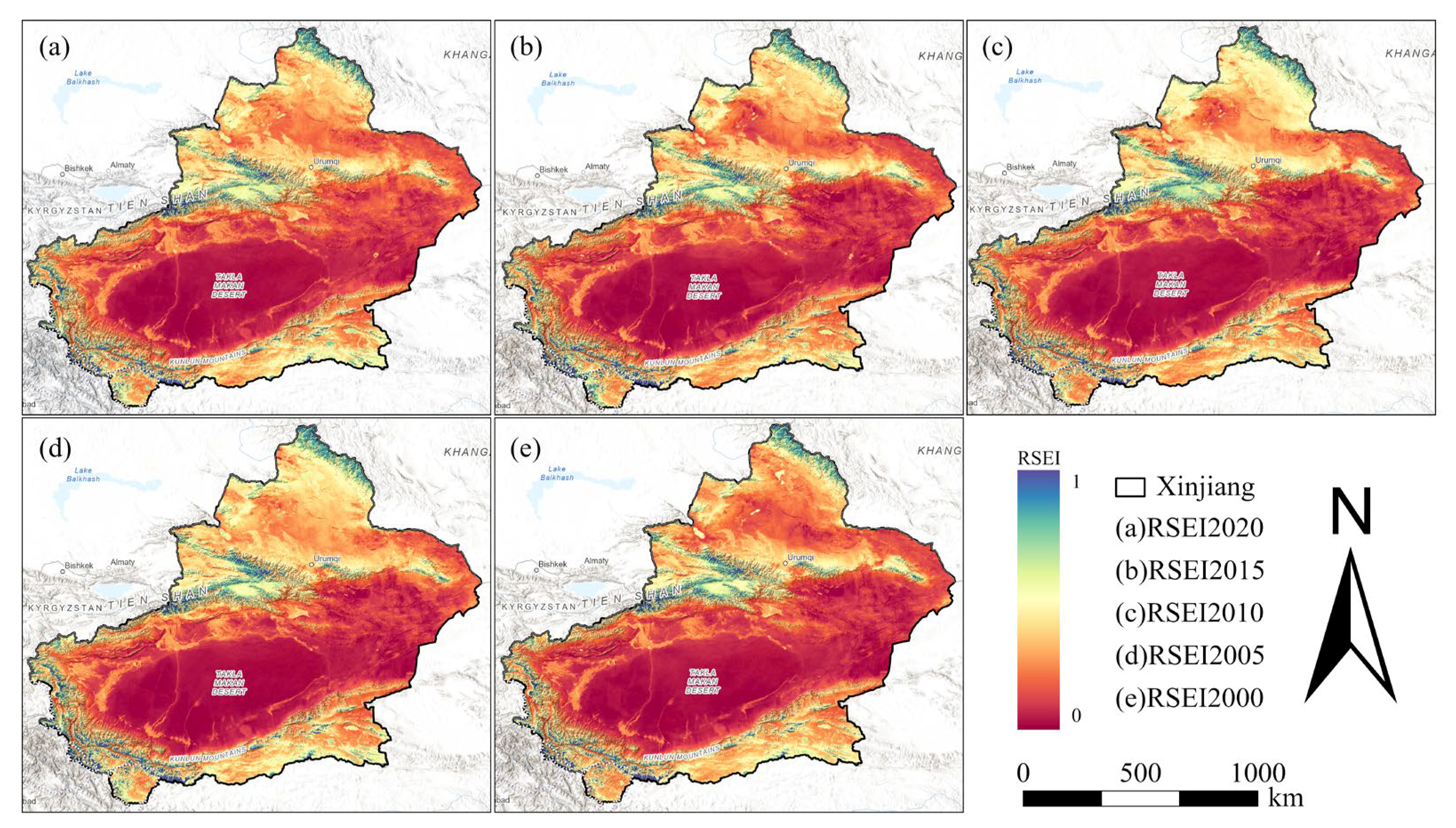

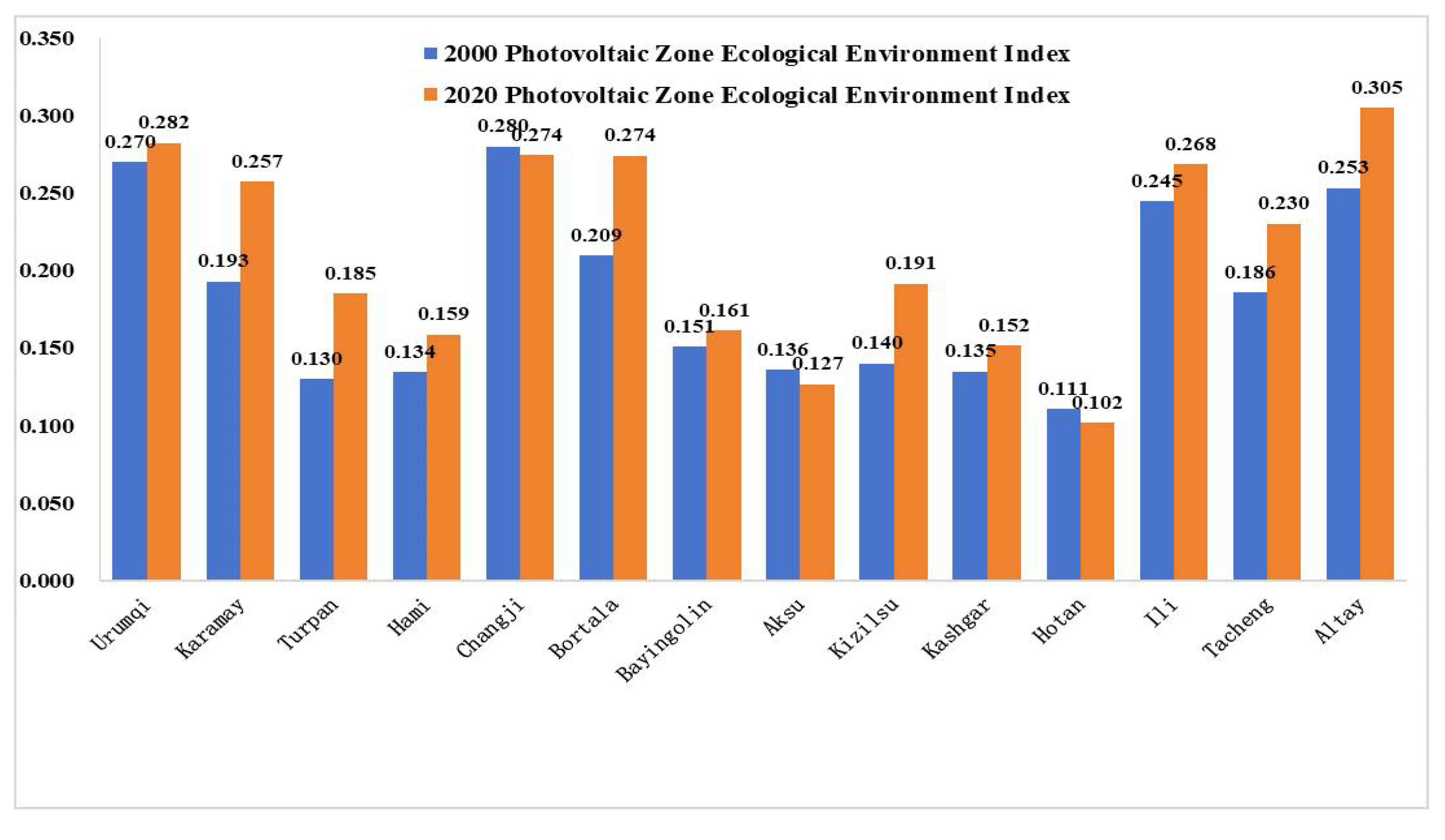

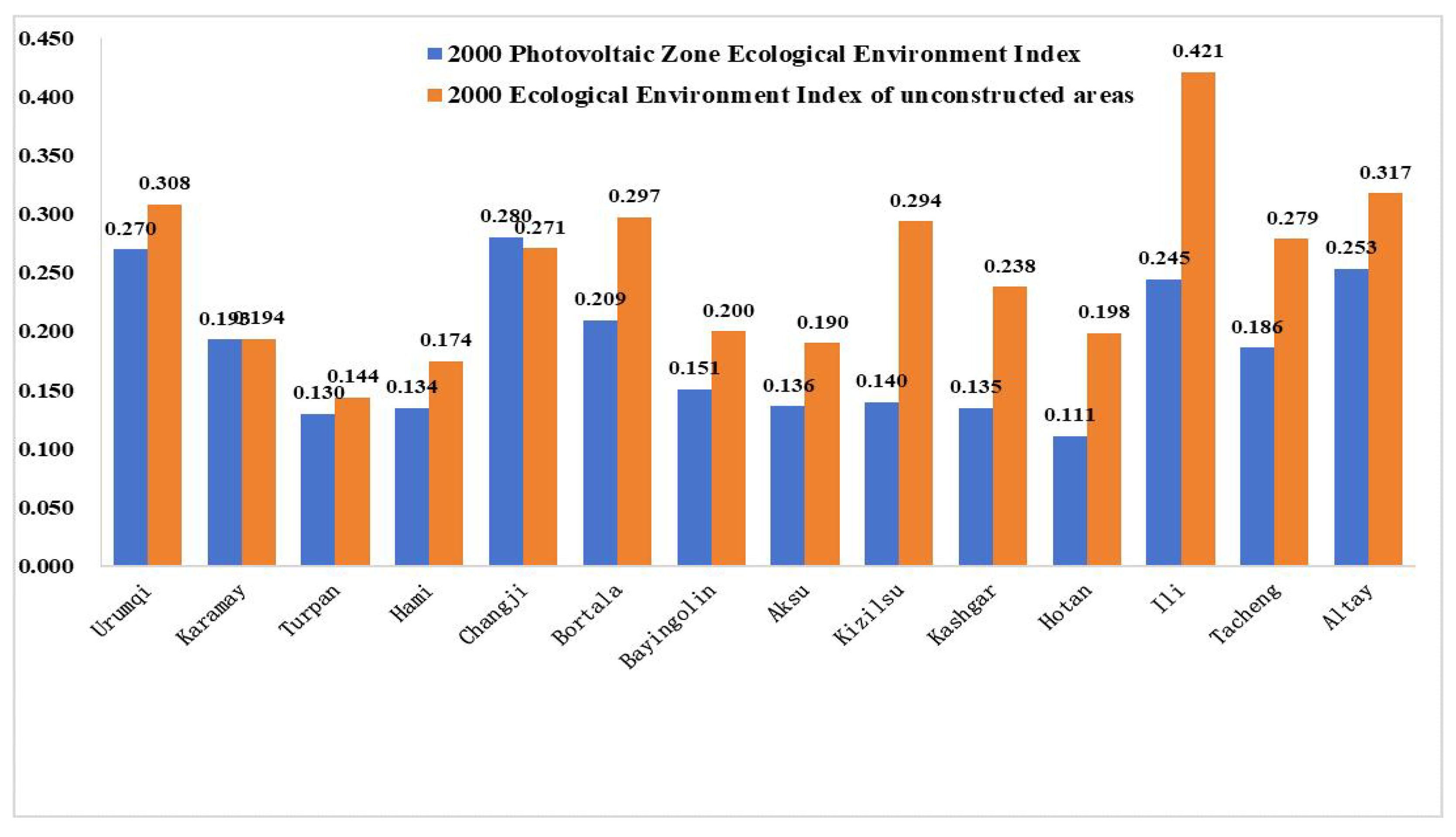
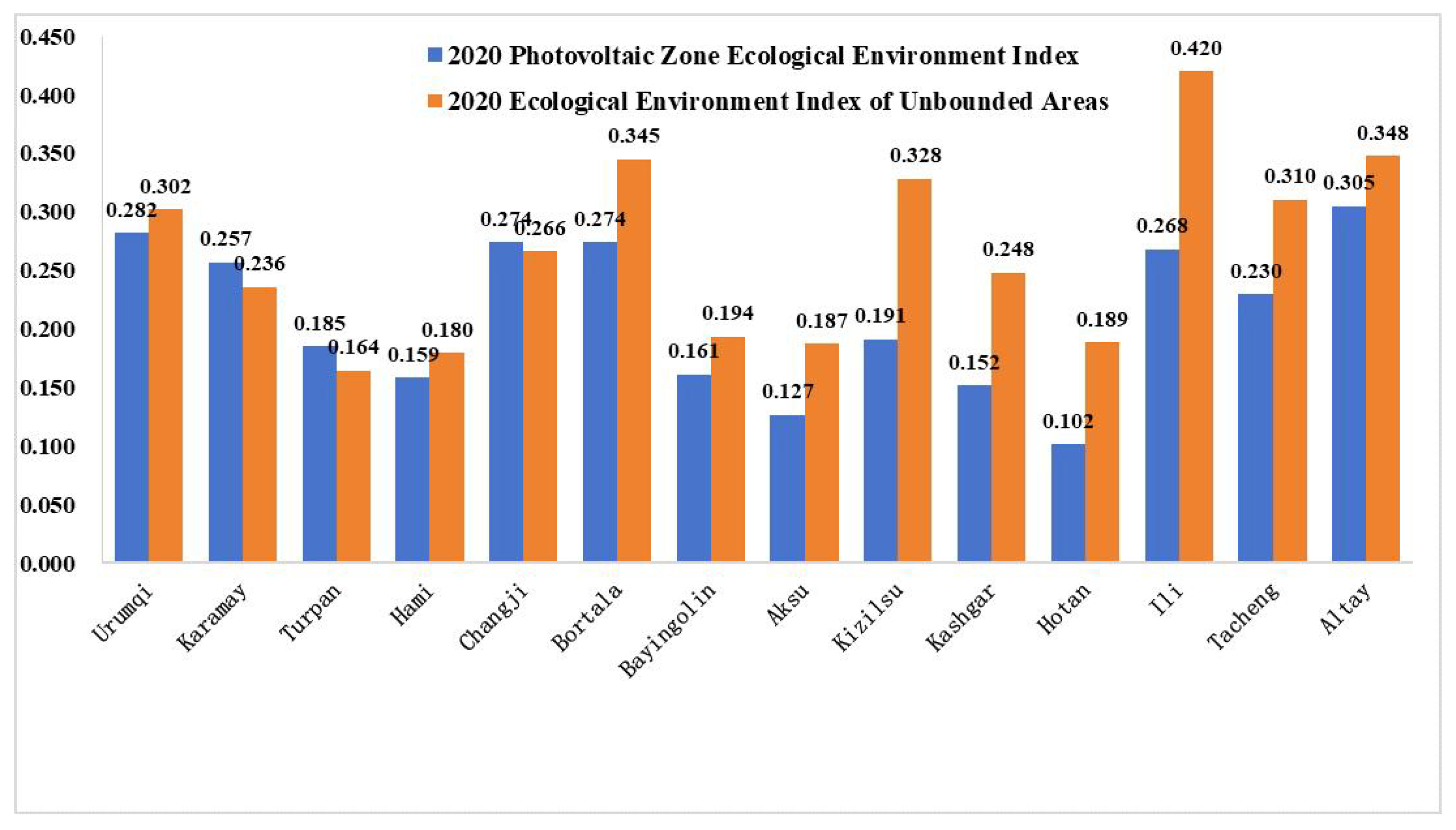
| Dataset | Satellite | Sensing | Resolution | Parameters Involved |
|---|---|---|---|---|
| MODIS/061/MOD09A1 | Terra | MODIS | 500 m | sur_refl_b01–sur_refl_b07 |
| MODIS/061/MOD11A1 | Terra | MODIS | 500 m | Daily surface temperature (LST) and emissivity values |
Disclaimer/Publisher’s Note: The statements, opinions and data contained in all publications are solely those of the individual author(s) and contributor(s) and not of MDPI and/or the editor(s). MDPI and/or the editor(s) disclaim responsibility for any injury to people or property resulting from any ideas, methods, instructions or products referred to in the content. |
© 2025 by the authors. Licensee MDPI, Basel, Switzerland. This article is an open access article distributed under the terms and conditions of the Creative Commons Attribution (CC BY) license (https://creativecommons.org/licenses/by/4.0/).
Share and Cite
Dilixiati, B.; Wang, H.; Gong, L.; Wei, J.; Lei, C.; Dang, L.; Zhang, X.; Gu, W.; Zhang, H.; Zhang, J. Land Use Dynamics and Ecological Effects of Photovoltaic Development in Xinjiang: A Remote Sensing and Geospatial Analysis. Land 2025, 14, 1294. https://doi.org/10.3390/land14061294
Dilixiati B, Wang H, Gong L, Wei J, Lei C, Dang L, Zhang X, Gu W, Zhang H, Zhang J. Land Use Dynamics and Ecological Effects of Photovoltaic Development in Xinjiang: A Remote Sensing and Geospatial Analysis. Land. 2025; 14(6):1294. https://doi.org/10.3390/land14061294
Chicago/Turabian StyleDilixiati, Babierjiang, Hongwei Wang, Lichun Gong, Jianxin Wei, Cheng Lei, Lingzhi Dang, Xinyuan Zhang, Wen Gu, Huanjun Zhang, and Jiayue Zhang. 2025. "Land Use Dynamics and Ecological Effects of Photovoltaic Development in Xinjiang: A Remote Sensing and Geospatial Analysis" Land 14, no. 6: 1294. https://doi.org/10.3390/land14061294
APA StyleDilixiati, B., Wang, H., Gong, L., Wei, J., Lei, C., Dang, L., Zhang, X., Gu, W., Zhang, H., & Zhang, J. (2025). Land Use Dynamics and Ecological Effects of Photovoltaic Development in Xinjiang: A Remote Sensing and Geospatial Analysis. Land, 14(6), 1294. https://doi.org/10.3390/land14061294











